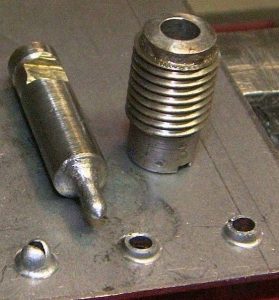
Punching is a metalworking process that’s used extensively in the manufacturing industry. It’s called “punching” because it involves punching a hole through a workpiece. It can be performed either by hand or using a machine, the latter of which is preferred as it’s able to forcefully drive holes through thick, hard metals. To learn more about pinching and how it works, keep reading.
The Basics of Punching
If a manufacturing company needs one or more holes created in a metal workpiece, it may perform punching. Punching offers a simple and effective way to create holes in metal workpieces. The workpiece is aligned between a punching tool — typically made of tungsten carbide or similar metal with a superior level of strength — and a die.
Once in place, the punching tool is driven down and into the workpiece, removing a piece of metal from the workpiece in the same shape as the die. If a circular die is used, the workpiece will have circular hole. If a triangular die was used, the workpiece will have a triangular hole. Regardless, punching always creates holes in the same shape as the die.
How Punching Is Performed
In the past, punching was performed by hand. Hand-punching tools are still available — and they are still used by some companies and individuals — but most punching now performed using a machine. Powered by hydraulic pressure, the machine forces the punching tool onto and through the workpiece. Below the punching press is a die block in the desired shape of the hole. As the punching press pushes through the workpiece, it leaves behind a hole in the shape of the die.
Advantages of Punching
Punching is a popular metalworking process in the manufacturing industry because of the unique advantages it offers over similar processes. According to Wikipedia, it’s the most cost-effective process for creating holes in metal workpieces. Second, punching is able to create holes in a variety of shapes. If a manufacturing company needs a hole in a specific shape, it can simply use a die in that shape. Third, punching is incredibly fast process, with a single punching happening in just a few split seconds.
Although it’s most commonly used with metal workpieces, punching can be performed on plastic workpieces as well. The process is pretty much the same, requiring the use of a punching tool and die to create holes in plastic workpieces. It’s typically used to remove excess plastic from workpieces during the final stages of assembly.
